View this article in another language
- 한국어
- English
- 日本語
- 中文
- العربية
- Español
- Français
- Deutsch
- Pусский
- Tiếng Việt
- Indonesian
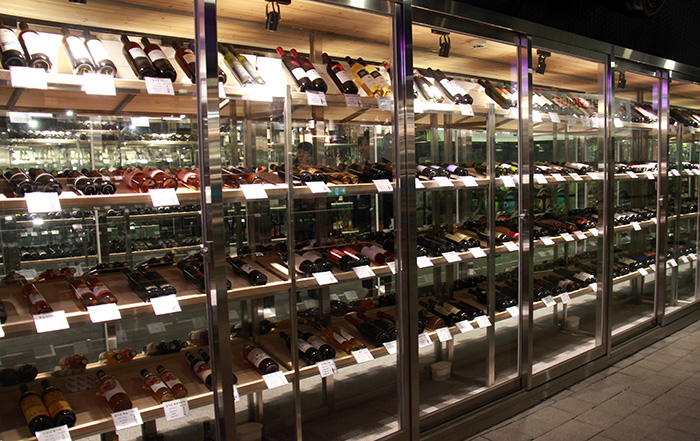
At the Wine Cave, a wine bar inside the Gwangmyeong Cave in Gwangmyeong, Gyeonggi-do Province, visitors can purchase some 170 different wines from 50 wineries across Korea.
Not a drop of wine is produced in Gwangmyeong, Gyeonggi-do Province, just southwest of Seoul, but it's certainly a place to visit to get a nice bottle of Korean wine. Inside the Gwangmyeong Cave, an arts and entertainment center run by the city government, there is a wine bar called the Wine Cave that carries some 170 different wines from 50 wineries representing 27 cities from across Korea. In other words, it's the hub of Korean wines.
All of the wines sold here have gone through blind tasting tests. Also, the wineries were visited for on-site inspections of the facilities and the production process before letting the wine go on sale here.
“Many visitors are surprised to hear that wines are produced in Korea, and they're surprised again about how good they taste,” said a Wine Cave representative. “In 2015, 37,500 bottles were sold here and in 2016, 43,000,” he said.
“The Gwangmyeong Cave has surely invigorated the Korean wine market,” he continued. “Before the cave opened, there was no place that promoted Korean wine and many local wineries were suffering from too much stock.”
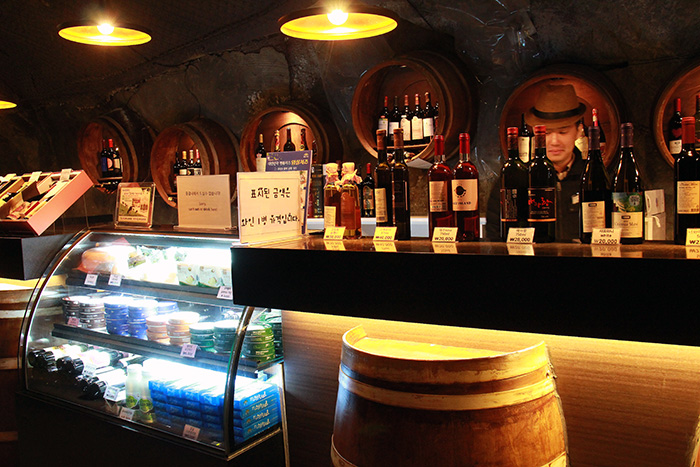
Some 170 different wines and cheeses, all made in Korea, are sold at the Wine Cave, a wine bar inside the Gwangmyeong Cave.
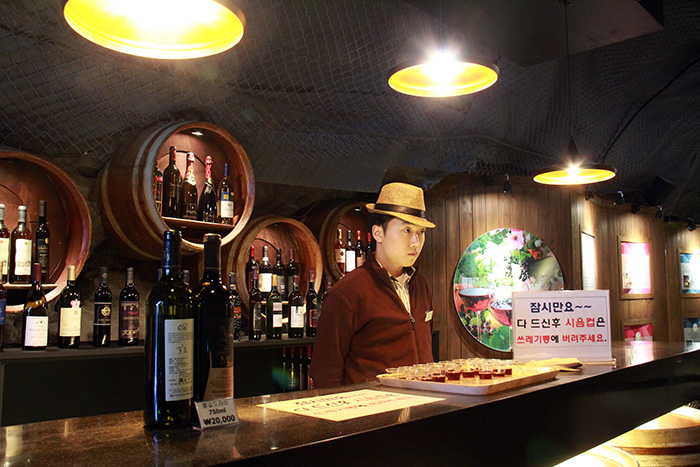
The Gwangmyeong Cave’s wine shop offers different types of samples every day.
At the Wine Cave, visitors can taste and buy wines stored in its specially designed wine cellar. Some local cheeses can also be bought here. There’s a restaurant called Maru de Cave that offers European meals with Korean wines, too.
The cave is not just a wine shop. It also provides helpful advice to wine producers by collecting feedback from consumers concerning price, taste and packaging.
For example, omija berry wines made in Mungyeong, Gyeongsangbuk-do Province, are made using only organic fruit. They were less popular, despite the good taste and quality, because of the higher price. The Gwangmyeong Cave staff suggested the winery make a more affordable product, made with non-organic fruit, to compensate for this, which drew more customers to buy omija fruit wines.
Korea.net sat down with Choi Jeongwook, the sommelier at the Wine Cave, to hear more about Korean wines and the Wine Cave.
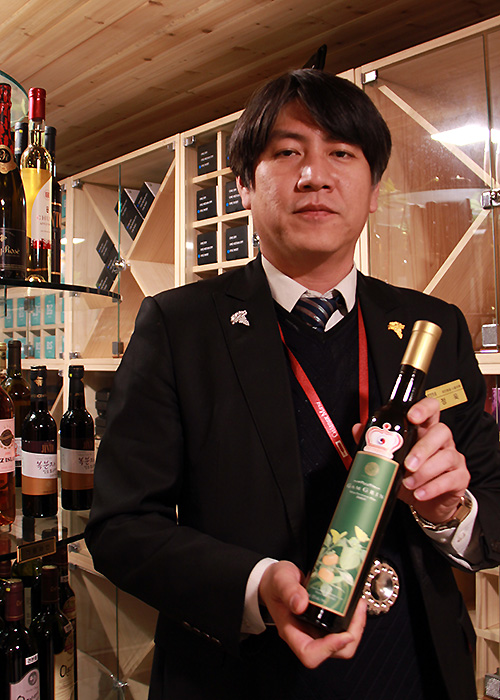
The Gwangmyeong Cave’s sommelier, Choi Jeongwook, introduces persimmon wine made in Cheongdo, Gyeongsangbuk-do Province.
-Why are wines sold in the Gwangmyeong Cave?
Before the Gwangmyeong Cave was turned into an arts and entertainment complex, it used to be an abandoned mine where seafood merchants stored and aged their salted shrimp. Because the cave maintained a suitable temperature for aging food throughout the year, Gwangmyeong Mayor Yang Kidae came up with the idea to age wine here. Although the place is currently only used for selling wine, construction for the aging and research facilities for wine is underway.
-Why doesn’t the shop sell Majuang, probably the most commonly sold brand of Korean wine?
Gwangmyeong-si City, in cooperation with other city governments, sells wines to support local grape farmers and wine producers. It's against our purpose to sell products from large companies.
Most Korean wines, with very few exceptions, are made at small farmland facilities, not large-scale factories. Majuang is a large company that makes a wide range of products, with both locally grown and imported fruit. Its products can be bought at regular retail stores and do not need further promotion. It's the same case with Bohae’s black raspberry bokbunja wine. Our goal here is to try to keep things strictly fair.
However, the cave does display some of Majuang’s products, as it's true that the company has made big contributions to the domestic wine industry.
-What's the difference between wine and other traditional fruit-based alcohols?
Fruit-based alcohol includes a mixture of fruit juice and alcohol. That means, combine crushed fruits and a spirit to make fruit alcohol. However, wine refers strictly to those beverages made from fermented fruit.
For example, if a crushed apple ferments and creates alcohol, it becomes "apple wine." However, if apple juice is mixed with alcohol from a separate source, it's called "apple alcohol."
The Gwangmyeong Cave visits the wineries and checks to see if they're equipped with separate fermenting tanks and aging tanks, to check if they make legitimate wine, before letting their product onto the shelves here.
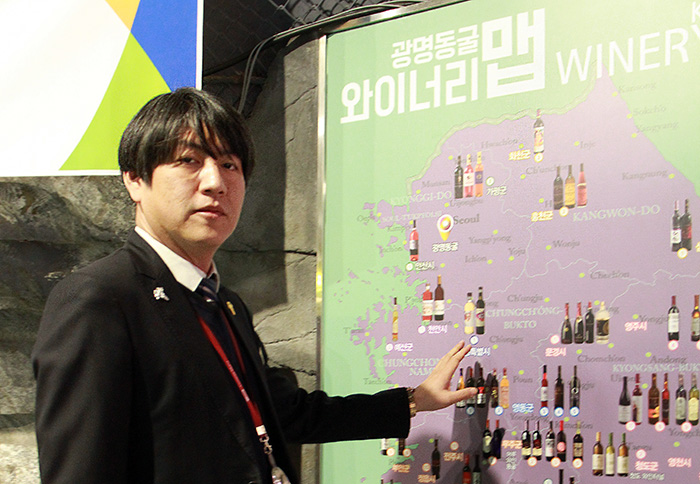
Choi Jeongwook, the sommelier at the Gwangmyeong Cave, talks about fruit wines made from local specialties.
-What are some characteristics of Korean wines, compared to those from other countries?
Korean wines are made with a variety of fruit. In European countries, wines are mostly made with grapes. Japanese wines are made from different kinds of fruit, but not as diverse as Korean wines.
About two-fifths of Korean wines are made from local fruits other than grape: peach and berries of the Acanthopanax koreanum (ogapi) from Sejong, omija berries from Mungyeong, persimmons from Cheongdo, kiwis from Sacheon, apples from Yesan, wild meoru grapes from Muju, black bokbunja raspberries from Gochang, mulberries from Sunchang and loquats from Wando.
-Could you introduce some special wines to us, please?
Some of the wines are very special. First is the omija berry wines made in Mungyeong. Mungyeong was the first Korean city to produce wine. The winery there is the only Korean winery capable of making sparkling wine, which requires a high level of technique. Also, to maintain the five flavors of the fruit, even after fermentation, is very difficult, which is why omija berry wines are praised by wine experts from around the world.
The second one is the persimmon wine made in Cheongdo. Last year, there was a ceremony regarding the Lascaux Cave exhibition, and one of the guests was a former French minister of culture. He tried the persimmon ice wine served with the dessert after the meal and he asked where he could get more of it. The wine was unavailable in Seoul, so I got five bottles delivered to him. He was very happy.
-Which wine would you recommend to tourists, especially those from Europe?
I recommend omija berry wine. It's actually exported to France. Omija berries only grow in East Asia, which is why the wine is considered unique. Also, it's one of the Korean wines of the highest quality.
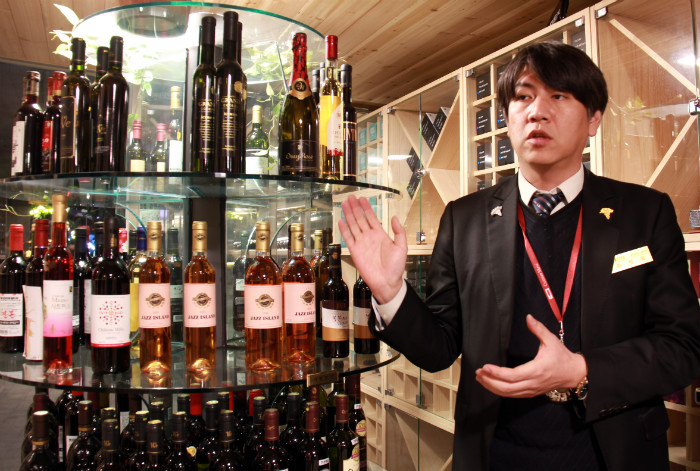
-What kind of food goes with Korean wine?
Sweet Korean wines go with Korean food made with soy sauce and gochujang red pepper paste. I recommend drinking wine with regional specialties.
Last year at our wine festival, we invited cooks to match some dishes to local wines. One of the pairs was loquat wine from Wando and that city’s specialty, abalone. Because the wine has a slightly bitter taste, the hot and spicy abalone dish made for a good combination. The wine made on Daebudo Island, where lots of grapes are grown, baby octopus cooked with doenjang soybean paste sauce was a good match.
This year, we plan to invite more cooks so more wines can be matched with foods. I want to recommend foods that really match with the wines and those that are easy to make at home.
-What's your perspective on the future of the Korean wine industry?
I can see the Korean wine industry improving even more in the future. It's a little embarrassing to say, because it sounds like self-praise, but after the Gwangmyeong Cave started to sell local wines only, the Korean wine industry has really become more vitalized.
In fact, there was no place that introduced Korean wines to consumers, or which sold them collectively. That’s why the farmers could only sell very little of what they produced. However, the Gwangmyeong Cave solved that problem.
In 2015, when the Wine Cave was first opened, we were only focusing on how much we sold. In 2016, however, we focused more on promoting Korean wine as a whole. In 2017, we will cooperate with the Ministry of Agriculture, Food and Rural Affairs and the Wine Production Association to improve exports, commercialization and the quality of Korean wine.
By Wi Tack-whan, Kim Young Shin
Korea.net Staff Writers
Photos: Kim Young Shin
ysk1111@korea.kr
Most popular
- Grammy-winning producer calls Suga of BTS 'amazing artist'
- 'Universal love, family' themes fuel success of 'King of Kings': director
- Seoul's 180 int'l conferences in 2024 rank 1st in Asia, 3rd in world
- Expansion of foreign app system raises tourist convenience
- Nat'l population diversity rose nearly 8% from 2018-22: study
